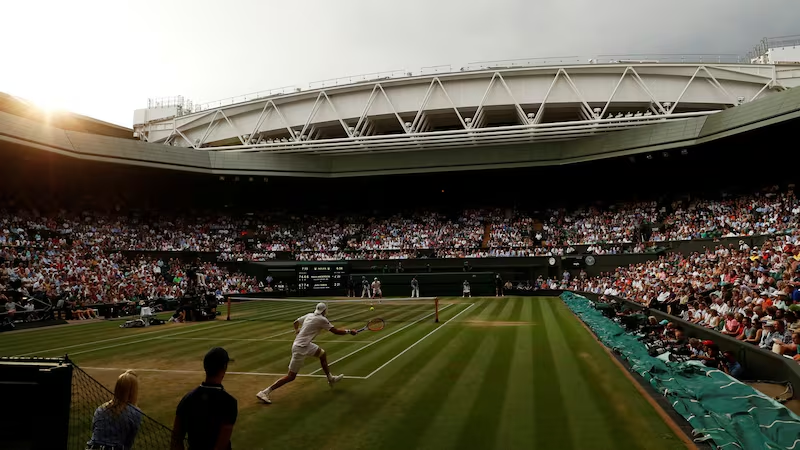Sometimes the statistics of a match can tell you nothing at all. Sometimes the statistics can tell you all you need to know without ever seeing a ball being hit.
Kevin Anderson and John Inser took to the Centre Court at 1.0pm on Friday. They stopped playing at 7.47pm saturated in sweat, dusty; two tall, thin players almost visibly shrunken.
As the hours ticked by their eyes had receded into their sockets as they fought off fatigue, each service game a majestic effort of will power and concentration.
In the end it was the American Isner, who blinked, Anderson winning 7-6 (8-6) 7-6 (7-5) 7-6 (11-9) 6-4 26-24 to earn a first ever final on Centre Court on Sunday.
In between lunch and early evening on a hot, muggy summer’s day in London, the 6’ 8’’ South African Anderson hit 49 aces at the 6’ 10’’ American, one of them at 137mph. The American hit 53 aces back, his best tipping 142 mph.
In the aftermath an emptied Anderson questioned the logic of having five set matches in Grand Slams. Articulate after the six hours and 36 minutes on court, he has until Sunday afternoon to recover before meeting Rafa Nadal or Novak Djokovic, who took to the court under a closed roof just before 8.00pm.
“It’s tough. I really don’t know,” said Anderson on his recovery for the final. “I really hope this is a sign for Grand Slams to change . . . for us to be out for that length of time. I really hope we can look at it and address this because in the end you don’t feel great.”

Both players were winning over 80 per cent of their first serves and as the night wore on it looked less and less likely that one of them would fracture.
The first three sets all went to ties breaks and in the fourth Anderson broke Isner for 6-4 to take the match to 2-2 and a fifth set, in which a tiebreak is not played. The fifth lasted for 50 games and 175 minutes by which stage the game of tennis had magically transformed into a compelling duel between two men.
In all Anderson won 11 break points and converted four with Isner claiming two from five won. Both players had chances but each time their serving pulled them through.
For that the fans stayed to watch. There are epics every year at Wimbledon with Isner involved in the record-breaking 11 hour 5 minutes slog with Nicolas Mahut in 2010. In that marathon the fifth set required eight hours and 11 minutes before Isner finally broke the Frenchman.
But in matches like these, where the points are short, the contest inevitably falls into tense, brief exchanges with short bursts of aggression and power and mounting pressure on each player to hold serve.
It was not pretty or subtle or flourishing. But as the games in the fifth set climbed higher and higher so too did the stress levels, the crowd understanding that the match could finish in a couple of loose serves from either player.
There was also the nagging point that many of the fans had come to see Nadal and Djokovic, who had been waiting to go on court for several hours. That was made clear to Anderson and Isner.
“Come on guys we want to see Rafa,” screamed a fan when the score was 13-13.
Anderson, a US Open finalist last year in his 34th Grand Slam is the first South African man to reach the Wimbledon final for 97 years. At 32 he was, he said “an example of sticking to your dreams and to keep believing in yourself”.
But the writing was on the wall before a ball was even pulverised. Prior to Friday night 13 of the 23 sets the two had previously played went to tiebreak deciders.
The only sense of balance between the two semi-finals was that all four players were in their 30s. That’s where the similarities ended. Anderson has only ever won four career titles and Isner 13. Djokovic has collected 68 career titles and Nadal 79 for a combined career prize money total of $211,730,183.
“I don’t know what to say right now,” said Anderson. “Playing like that in those conditions is really tough. You really feel this is a draw but someone has to win. On the other side I don’t how you can take that after playing for so long.
“All I can say is congrats to John on such a great tournament. Semi-final here is a great effort from him. I’ve got to recover as much as I can. Nadal, Djokovic neither of those guys need an introduction.”
In the final game the match spectacularly opened up for Anderson, when he fell flat on his back after hitting a backhand.
But scrambling to his feet he hit the return and crucially won the point. Maybe that was an omen. The crowd rose. The point took the score to 0-30, a mini break. Then a forehand winner for 0-40 and suddenly Anderson had three match points.
Isner rescued one for 15-40 but an exhausted forehand floated from his racquet wide and beyond the tramlines. An almost disbelieving Anderson had won the longest semi-final in Wimbledon history.
“I’m into the final of Wimbledon,” he said afterwards. “And that’s part of a dream come true.”
Novak Djokovic and Rafa Nadal will resume their semi-final match on Saturday. Playing under the closed roof on Centre Court the match was was taken off after the curfew time of 11.00pm was reached. The pair stopped playing with Djokovic leading 2-1 in sets to a howl of boos from the crowd.














